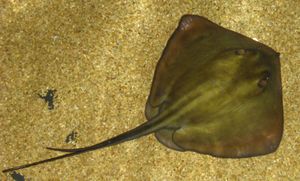We need you! Join our contributor community and become a WikEM editor through our open and transparent promotion process.
Stingray injury
From WikEM
Contents
Background
- Stinger punctures skin to introduce heat-labile venom
- Generally causes local symptoms without systemic effects
Clinical Features
- Symptoms can vary by species
- Local pain, irritation, erythema
- Systemic symptoms can include vomiting, muscle cramps, hypotension, paralysis, cardiac arrest
Differential Diagnosis
Marine toxins and envenomations
- Toxins
- Stingers
- Stingray injury
- Venomous fish (catfish, zebrafish, scorpion fish, stonefish)
- Lionfish
- Sea urchins
- Cone shells
- Nematocysts
- Jellyfish (Cnidaria)
- Portuguese man-of-war
- Coral reef
- Fire Corals
- Sea anemones
- Sea wasps
- Bites
Evaluation
- Clinical diagnosis
- Consider x-ray to evaluate for retained foreign body (stinger)
Management
- Immediately immerse wound in hot water (45°C for 30-90min) [1]
- Supportive care
- Remove spines and stinger, if visible
- Tetanus prophylaxis
- Prophylactic antibiotics are controversial - if used, give Ciprofloxacin to cover Vibrio vulnificus
Disposition
- Discharge
See Also
External Links
References
- ↑ Atkinson PRT. Is hot water immersion an effective treatment for marine envenomation? Emergency Medicine Journal. 2006;23(7):503–508. doi:10.1136/emj.2005.028456.
Authors
Ross Donaldson, Michael Holtz, Daniel Ostermayer, Neil Young


